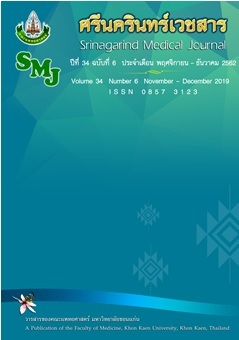Effectiveness of Artificial Cheeks for Bag Mask Ventilation in Elderly Patients Receiving General Anesthesia
Keywords:
effectiveness, artificial cheeks, bag-mask ventilation, general anesthesia, ประสิทธิผล, อุปกรณ์แทนที่บริเวณร่องแก้ม, ช่วยหายใจ, ผู้สูงอายุ, การให้ยาระงับความรู้สึกแบบทั้งตัวAbstract
ประสิทธิผลต่อการใช้อุปกรณ์แทนที่บริเวณร่องแก้มสำหรับช่วยหายใจในผู้ป่วยสูงอายุที่มารับการให้ยาระงับความรู้สึกแบบทั้งตัว
บุศรินทร์ ศรีญาณลักษณ์, นิรนุช ศิริพันธุ์, มลิวัลย์ ออฟูวงศ์
ภาควิชาวิสัญญีวิทยา คณะแพทยศาสตร์ มหาวิทยาลัยสงขลานครินทร์ สงขลา 90110
หลักการและวัตถุประสงค์ ผู้สูงอายุมักพบปัญหาช่วยหายใจทางหน้ากากยากเนื่องจากไม่มีฟันและมีแก้มตอบ ทำให้การครอบหน้ากากให้สนิททำได้ยาก มีลมรั่วออกมารอบ ๆ หน้ากากช่วยหายใจ ทำให้ช่วยหายใจไม่ได้ประสิทธิภาพ ผู้วิจัยจึงได้ประดิษฐ์อุปกรณ์เพื่อใช้ในการช่วยหายใจในผู้ป่วยสูงอายุที่มารับการให้ยาระงับความรู้สึกแบบทั้งตัว การศึกษานี้มีวัตถุประสงค์เพื่อประเมินประสิทธิผลต่อการใช้อุปกรณ์แทนที่บริเวณร่องแก้มสำหรับช่วยหายใจในผู้ป่วยสูงอายุที่มารับการให้ยาระงับความรู้สึกแบบทั้งตัว
วิธีการศึกษา: เป็นการศึกษาเชิงพรรณนา โดยแบ่งเป็น 3 ขั้นตอน คือ ขั้นตอนการประดิษฐ์ ขั้นตอนการใช้อุปกรณ์แทนที่ร่องแก้ม และขั้นตอนการประเมินผลโดยใช้แบบสอบถามประเมินโดยบุคลากรทางวิสัญญี 6 หัวข้อ ได้แก่ 1. หน้ากากช่วยหายใจครอบใบหน้าได้แนบสนิท 2. สามารถช่วยหายใจได้ดี (ดูจากการเคลื่อนไหวของทรวงอก และเห็นกราฟของระดับคาร์บอนไดออกไซด์ในลมหายใจสม่ำเสมอ) 3. มีความสะดวกในการใช้งาน 4. สามารถทำความสะอาดได้ง่าย 5. มีความสะดวกในการเก็บรักษา และ 6. ความพึงพอใจโดยรวม โดยให้คะแนนดังนี้ 4 = ดีมาก 3 = ดี 2 = ปานกลาง 1 = ปรับปรุง โดยคิดขนาดกลุ่มตัวอย่างตามประสิทธิผลอย่างน้อยร้อยละ 90 ได้กลุ่มตัวอย่าง 40 ราย
ผลการศึกษา: ผู้ประเมินให้คะแนนเฉลี่ยในภาพรวมส่วนใหญ่ร้อยละ 80-89 อยู่ในระดับดี 3.2-3.25 คะแนน หัวข้อสะดวกในการเก็บรักษาและทำความสะอาดได้ง่ายให้คะแนนเฉลี่ยส่วนใหญ่มากกว่าร้อยละ90 อยู่ในระดับดีมาก 3.7-3.9 คะแนน หัวข้อที่ได้คะแนนมากที่สุดคือทำความสะอาดได้ง่าย (3.9 คะแนน) ส่วนหัวข้อหน้ากากช่วยหายใจครอบใบหน้าได้แนบสนิทได้คะแนนน้อยที่สุด (3.2 คะแนน)
สรุป: ผลการประเมินประสิทธิผลต่อการใช้อุปกรณ์แทนที่บริเวณร่องแก้มสำหรับช่วยหายใจในผู้ป่วยสูงอายุที่มารับการให้ยาระงับความรู้สึกแบบทั้งตัว พบว่าส่วนใหญ่อยู่ในระดับดี หัวข้อสะดวกในการเก็บรักษาและทำความสะอาดได้ง่ายอยู่ในระดับดีมาก สามารถนำอุปกรณ์มาใช้ช่วยหายใจในผู้ป่วยสูงอายุที่มารับการให้ยาระงับความรู้สึก
Background and Objective: Lack of teeth and sunken cheeks could cause bag-mask ventilation difficulty in anesthetized elderly patients because of inadequate air-tight seal. Those are the reason why we invented artificial cheeks to solve the problems. The purposes of this study were to evaluate the effectiveness of using artificial cheeks during bag-mask ventilation.
Methods: The process of investigation were divided into 3 steps. First step was artificial cheeks invention. Second step was the devices application for with patients, and third step was evaluation by using questionnaire from anesthesia personnels who had used artificial cheeks. The respondents were asked to evaluate all 6 aspects; 1) good sealness 2) easy to ventilate 3) convenience to use 4) easy cleanness 5) easy storage and 6) overall satisfaction. The evaluated scales included the followings; 4 = excellent, 3 = good, 2 = fair, 1 = poor. The sample size calculation was based on the effectiveness of using artificial cheeks of at least 90 %, so the total sample size was 40.
Results: The overall score of effective assessment (80-90%) evaluated by respondents was 3.2-3.25. The average of highest score of all aspects (>90%) was easy cleanness 3.7-3.9 whereas the average of lowest score was good sealness (3.2).
Conclusion: The effectiveness of using artificial cheeks for bag-mask ventilation in elderly patients were moderate to high. The artificial cheeks can be used to assist bag-mask ventilation in anesthetized elderly patient.
References
ภารดี นานศิลป์. แกนความรู้พยาบาลผู้สูงอายุ: ผู้สูงอายุคือใคร อายุ หรือ ปัจจัยใดช่วยกำหนด. พยาบาลสาร 2558; 42(ฉบับพิเศษ): 156-60.
รายงานประจำปีและสถิติภาควิชาวิสัญญี คณะแพทยศาสตร์ มหาวิทยาลัยสงขลานครินทร์; 2559.
พัชรียา นิวัฒน์ภูมินทร์. การให้ยาระงับความรู้สึกในผู้ป่วยสูงอายุ. ใน: อรลักษณ์ รอดอนันต์, วรินี เล็กประเสริฐ, ฐิติกัญญา ดวงรัตน์, บรรณาธิการ. ตำราฟื้นฟูวิชาการวิสัญญีวิทยา. พิมพ์ครั้งที่ 1. กรุงเทพฯ: บริษัทธนาเพรส จำกัด; 2555: 317-31.
Charuluxananan S. Patient Safety in Anesthesia. In: Charuluxananan S, editor. Anesthesiology: Quality&Safety. Samutsakhon: Winpressproduction house; 2005: 62-83.
อิสราภรณ์ สิงห์กันต์, วิชญา ศุภโอภาสพันธุ์. หลักการดูแลผู้ป่วย difficult airway. ใน: อรลักษณ์ รอดอนันต์, วรินี เล็กประเสริฐ, ฐิติกัญญา ดวงรัตน์, บรรณาธิการ. ตำราฟื้นฟูวิชาการวิสัญญีวิทยา. พิมพ์ครั้งที่ 1. กรุงเทพฯ: บริษัทธนาเพรส จำกัด; 2555: 46-50.
Kheterpal S, Han R, Tremper KK, Shanks A, Tait AR, O'Reilly M, Ludwig TA. Incidence and predictors of difficult and impossible mask ventilation. Anesthesiology 2006; 105: 885-91.
Komatsu R, Kasuya Y, Yogo H, Sessler DI, Mascha E, Yang D, et al. Learning curves for bag-and-mask ventilation and orotracheal intubation: an application of the cumulative sum method. Anesthesiology 2010; 112: 1525-31.
อรรัตน์ กาญจนวนิชกุล. การจัดการทางเดินหายใจและใส่ท่อช่วยหายใจ. ใน: วิรัตน์ วศินวงศ์,
ธวัช ชาญชญานนท์, ศศิกานต์ นิมมานรัชต์, ธิดา เอื้อกฤดาธิการ, บรรณาธิการ. ตำราวิสัญญีวิทยาพื้นฐาน. พิมพ์ครั้งที่ 2. สงขลา: ชานเมืองการพิมพ์; 2552: 208-24.
Rosenblatt WH, Sukhupragarn W. Airway management. In, Barash PG and et al, eds. Clinical anesthesia. 6th ed. Philadelphia: Lippincott Williams & Wilkins; 2009. p. 751-92.
Phero JC, Ovassapian A, Hurford WE. Evaluation of the patient with a difficult airway. In: Longnecker DE, et al, eds. Anesthesiology. New York: The McGraw-Hill Companies; 2008: 122-33.
Lavery GG, McCloskey BV. The difficult airway in adult critical care. Crit Care Med 2008; 36: 2163-73.
El-Orbany M, Woehlck HJ. Difficult mask ventilation. Anesth Analg 2009; 109: 1870-80.
el-Ganzouri AR, McCarthy RJ, Tuman KJ, Tanck EN, Ivankovich AD. Preoperative airway assessment: predictive value of a multivariate risk index. Anesth Analg 1996; 82: 1197-204.
Williamson JA, Webb RK, Szekely S, Gillies ER, Dreosti AV. The Australian Incident Monitoring Study. Difficult intubation: an analysis of 2000 incident reports. Anaesth intensive Care 1993; 21: 602-7.
Soleimanpour H, Sarahrudi K, Hadju S, Golzari SE. How to overcome difficult-bag-mask-ventilation: Recents approaches. Emerg Med 2012; 2: e116.
Susheela T, Anju G, Reeta S, Kirti K. Edentulous patient and face mask ventilation. Indian J Anesth 2008; 52: 347–8.
Golzari SE, Soleimanpour H, Mehryar H, Salarilak S, Mahmoodpoor A, Panahi JR, et al. Comparison of three methods in improving bag mask ventilation. Int J Prev Med 2014; 5: 489-493.
Racine SX, Solis A, Hamou NA, Letoumelin P, Hepner DL,Beloucif S, Baillard C. Face mask ventilation in edentulous patients: A comparison of mandibular groove and lower lip placement. Anesthesiology 2010; 112: 1190–3.


